Here are 10 beautiful castles to visit around Lago di Garda.
With crenellated walls and fortified towers, they have been guarding for centuries the towns dotted around Italy’s largest lake and have dozens of stories to tell.
Built during the Middle Ages, many of the castles around Lake Garda were erected over former Roman forts. Nowadays, some of the castles are almost fully preserved. A few have been reduced to ruins by the hands of time. And several of them house must-see local museums. One of the castles on Lake Garda even has an 18th-century citrus garden with a pond with turtles and fish under the lemon and orange trees.
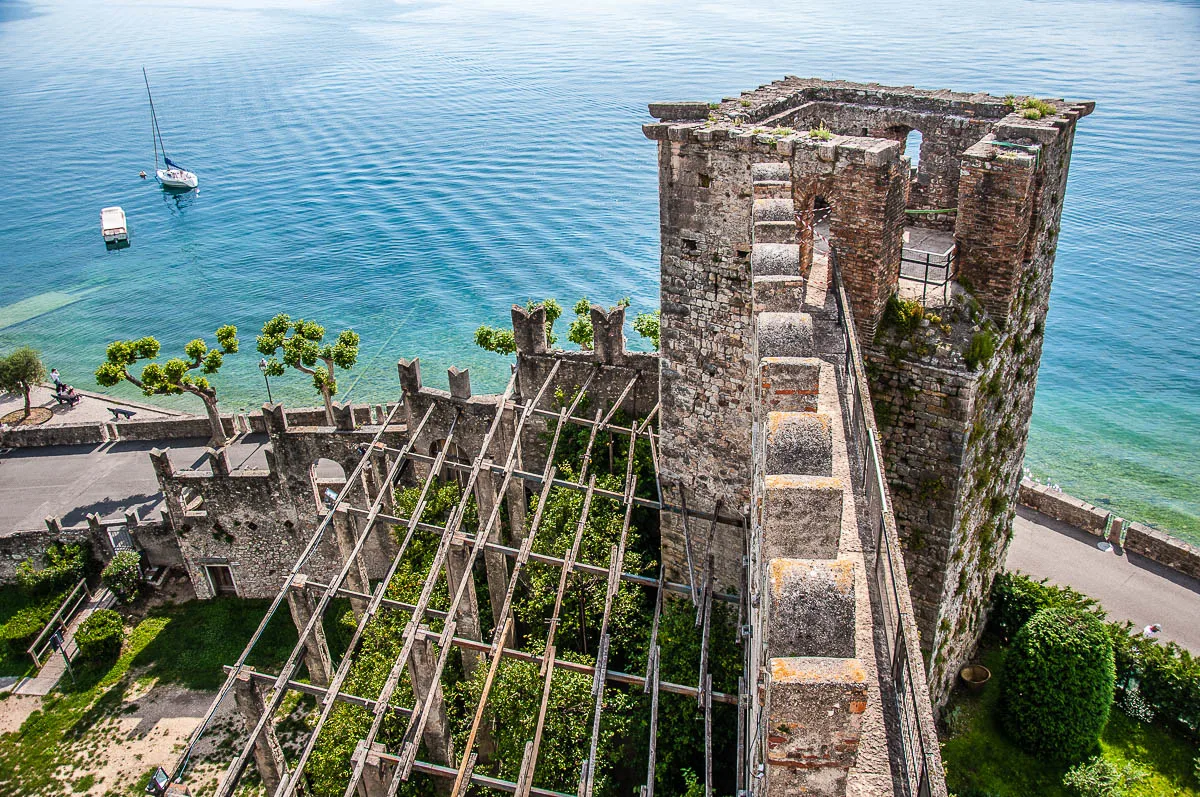
The castles around Lake Garda are a great destination for exciting day trips from the nearby large Italian cities like Verona, Milan, Trento, Rovereto, and Venice. Or they can be the highlight of a holiday spent on the shores of Italy’s largest lake.
No matter how many of them you have a chance to see – one, two or ten – the Lake Garda castles are bound to impress you with their robust architecture and many layers of history.
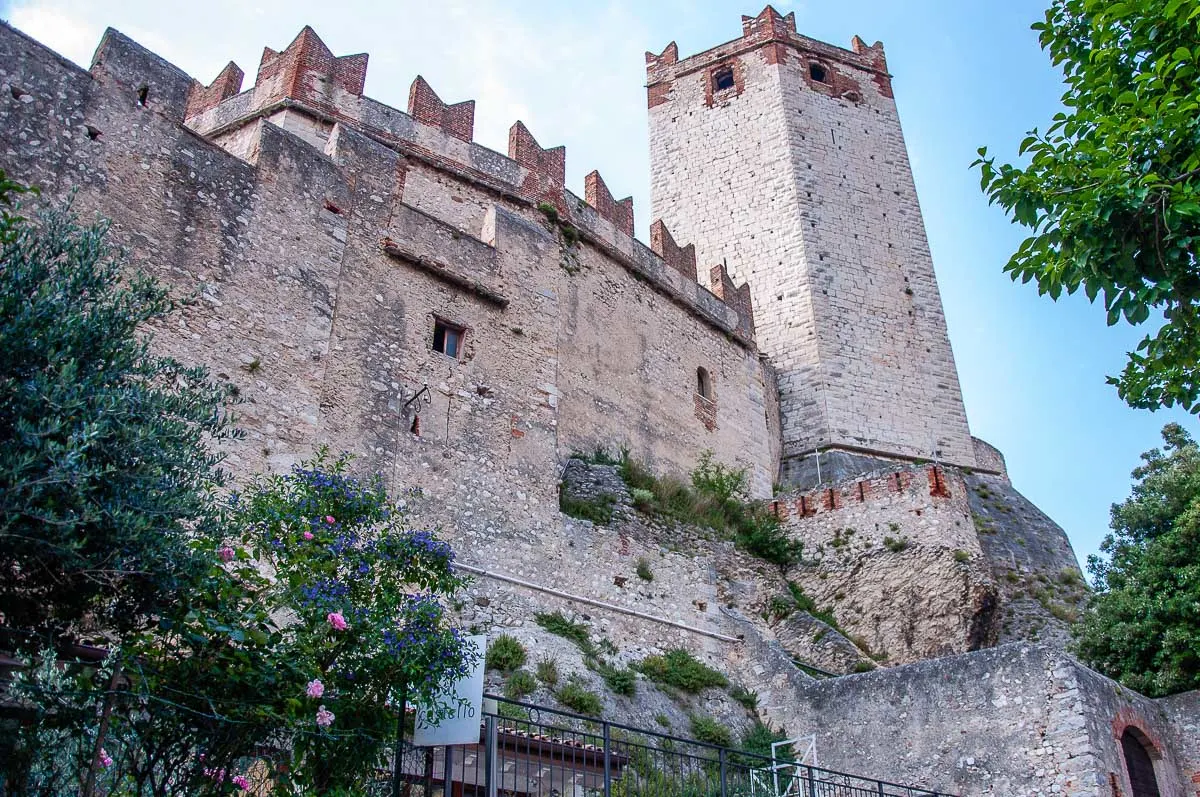
So, in this blog post today, I will show you 10 of the most beautiful castles to visit around Lake Garda in Italy. Some of them sit right on the lakefront whereas a couple are a short drive away from the lake. All of them are easy to reach by car and most are very easy to reach by public transport, too.
For help with your travel plans, please, have a look at this blog post giving you the 8 best ways to travel around Lake Garda. To get a visual idea of the locations of the different castles, further down in this blog post I have also included a map.
Now, starting from the Scaliger Castle in the town of Sirmione we will travel up along the eastern shores of Lake Garda stopping to look at other medieval castles in the area. Once we reach Riva del Garda and its fortress at the northern extremity of the lake, we will close the circle by travelling down the western shores of Lake Garda to the towns of Desenzano del Garda and Vallegio sul Mincio to see their castles, too.
I hope that you will enjoy visiting these 10 Lake Garda castles just as much as I did.
In addition, at the end of this article, you will also find lots of practical information and insider tips to make planning your day trip to or holiday at Lake Garda in Italy an easy and enjoyable experience. From nearest airports, travel times and transport options to accommodation, geographical information, and weather stats, this is a great foundation to help you organise as best as possible your visit to Lake Garda.
Now, have a look!
10 Beautiful Castles to Visit Around Lake Garda, Italy
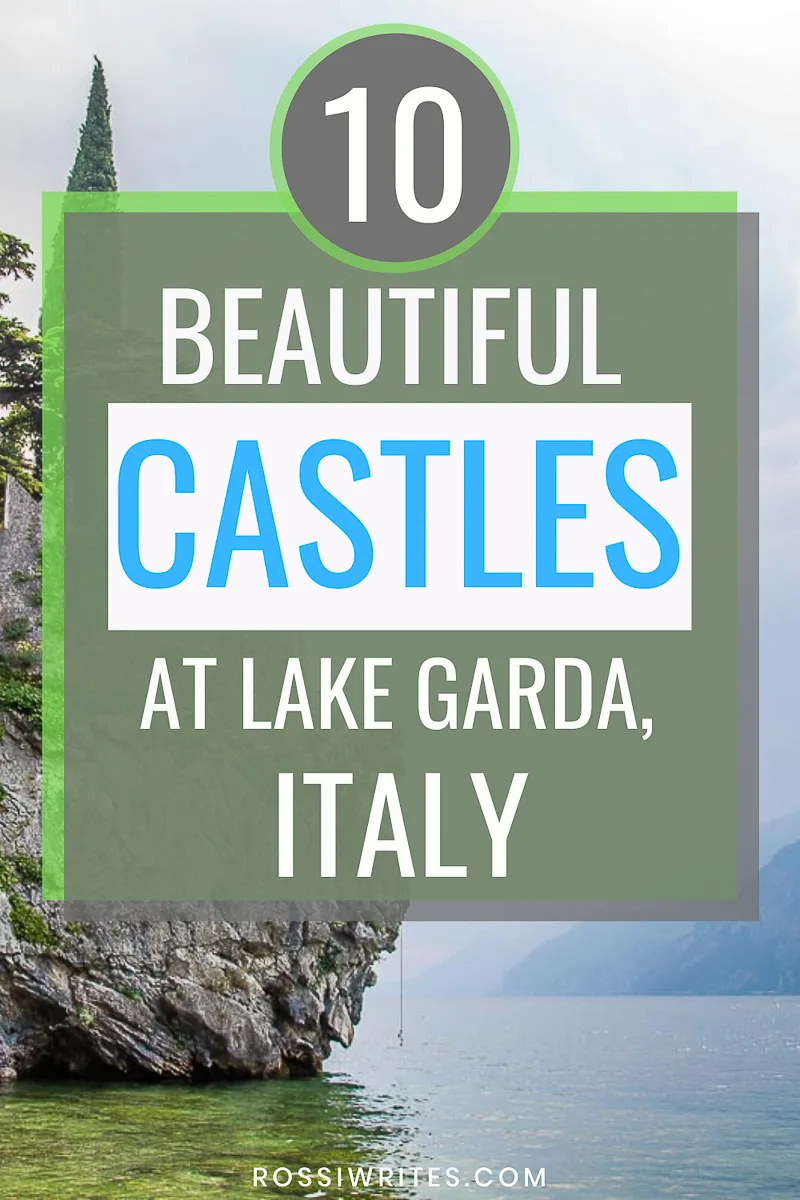
A Few Words About the Scaliger Dynasty
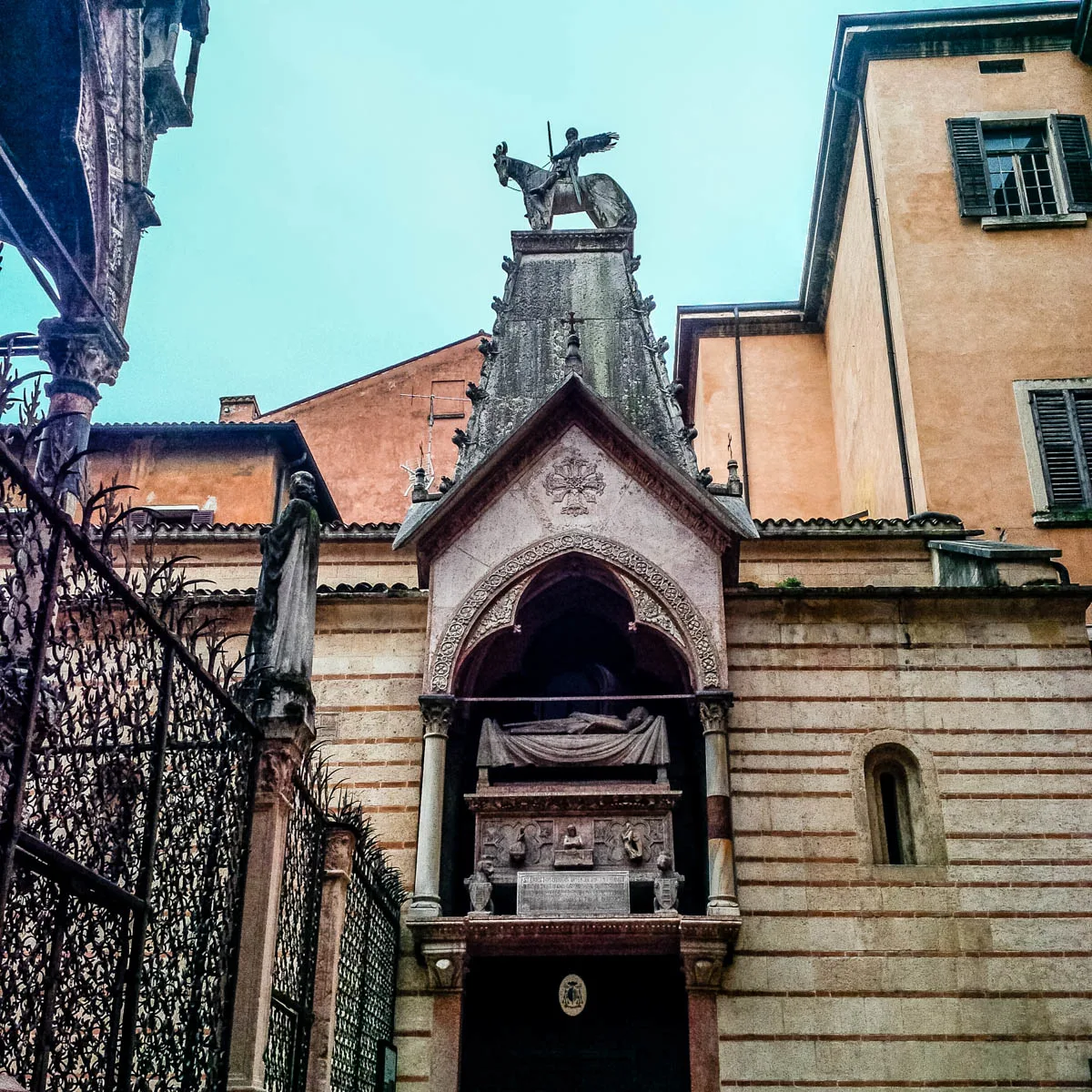
You will notice that many of the castles on this list carry the name Scaliger. This is so because they were either built or completely remodelled by the powerful Scaliger dynasty – the medieval rulers of the nearby city of Verona.
Nowadays Lake Garda is predominantly a holiday destination and millions of people head to its picturesque lakefront towns in search of good views, good food, and relaxation. Yet, during the Middle Ages, Lago di Garda was an important strategic lake. Merchant ships crisscrossed its waters and whoever was in charge of the lakefront towns was also in charge of the taxes levied on them.
Hence, many rulers and several dynasties fought for control of the area. The Della Scala – known as the Scaligers – was a family of powerful lords who had Verona under their rule for 125 years in the 13th and 14th centuries. You will see how almost every castle on this list has a direct connection with the Scaligers and many of them preserve their original Scaliger architecture and name to this day.
The above photo shows you the so-called Arche Scaligeri – the Gothic funerary monuments of the Scaliger dynasty in the city of Verona, Italy.
1. Scaliger Castle in Sirmione on Lake Garda, Italy
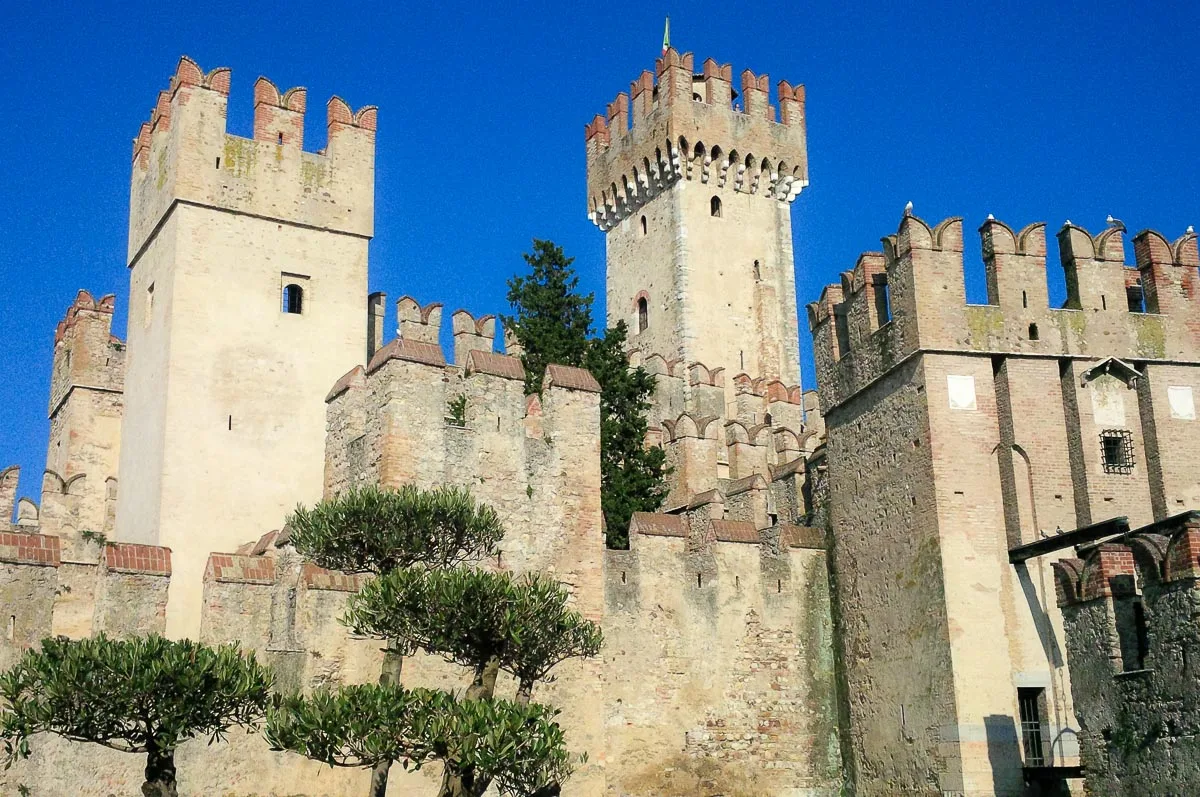
The Scaliger Castle in the town of Sirmione is, without a doubt, the most famous castle on the shores of Italy’s Lake Garda. It stands on the edge of the promontory Sirmio which juts deep into the lake waters and on the tip of which the picturesque historic centre of Sirmione is built.
The castle is surrounded by water on all sides and can only be accessed via two drawbridges which, nowadays, are permanently in place. With its crenellated wall and tall towers, Sirmione’s Scaliger Castle cuts a striking silhouette. In English, it is widely referred to as the Sinking Castle. The reason for this is that at a first glance, it seems that one of the castle’s courtyards is completely flooded by the lake. In fact, this is not a courtyard but a fortified port where, centuries ago, the Scaliger fleet was anchored.
The castle was built in the 13th and 14th centuries by the Scaliger dynasty. A Roman fort had once stood at the same spot. The castle has three towers and a donjon which is 47 meters high. From the top of the castle’s walls and towers, you can enjoy stunningly beautiful views over the red rooftops of Sirmione and the blue waters of Lake Garda.
There are several other places of interest to see when in Sirmione. From the town’s spa pools and beautiful beach to the massive ruins of a once splendid Roman villa, Sirmione is one of the largest gems in the crown of Lake Garda. Its impressive Scaliger Castle dominates the entry point to the town’s historic centre. Catching your first glimpse of it sets the tone for the whole day and you know that you have arrived at a very special and beautiful place.
2. Fortified Town of Peschiera del Garda on Lake Garda, Italy
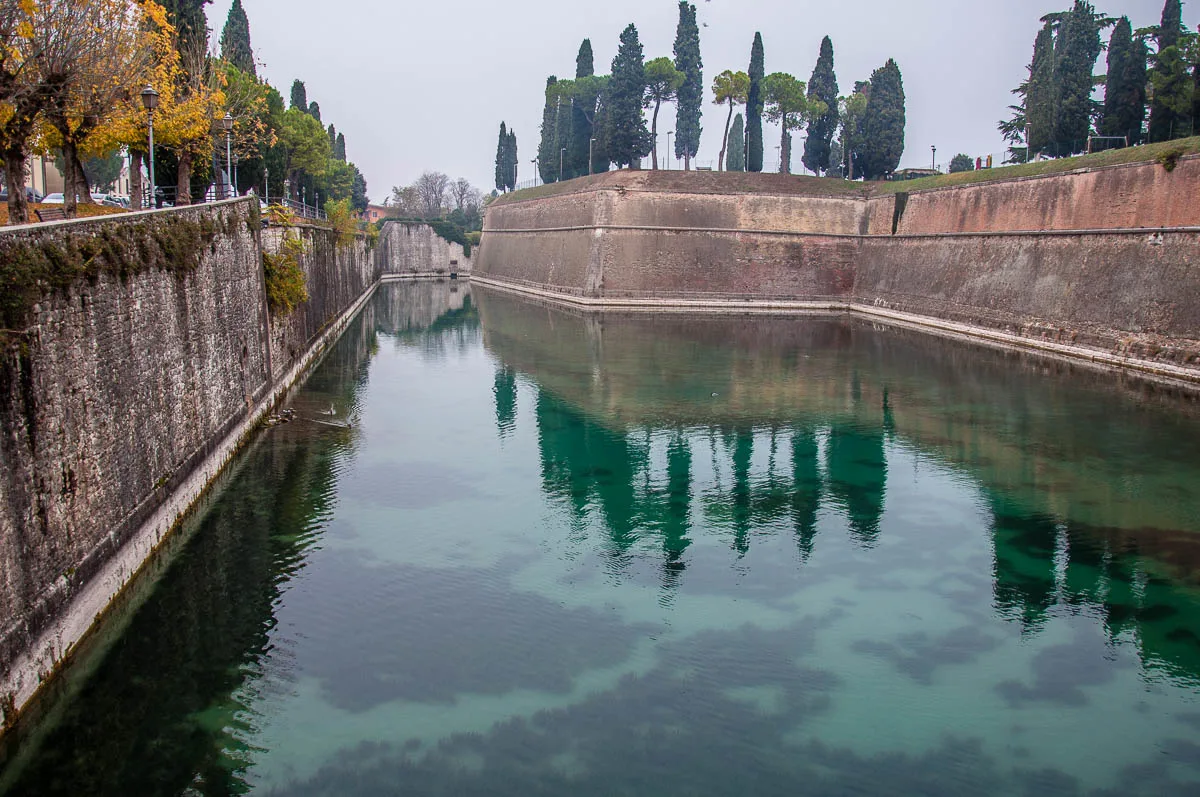
Peschiera del Garda is the perfect example of a fortified town. Positioned right on the spot where the River Mincio flows out of Lake Garda, Peschiera is built on a series of small islands and it’s surrounded by massive defensive walls. The walls – thick and sturdy – seem to grow from the bottom of the lake. Such is the impression they produce and their historical value, too that in 2017 Peschiera del Garda became a UNESCO World Heritage Site.
With pre-historic roots and Roman heritage, Peschiera del Garda was mentioned by Pliny the Elder in his Natural History as a place abundant in fish. It is thought that the town must have been originally fortified during the Roman era for it served as the base of the Roman military float for Lacus Benacus (the Latin name of Lake Garda). At the beginning of the 13th century, Peschiera was fortified again. The Scaliger rulers played an important part by completing the walls and erecting a fortress.
In 1440, Peschiera del Garda became part of the Republic of Venice. The Venetians renovated the medieval fortifications, added five massive bastions to them, opened large monumental gates at a couple of strategic points in the walls, and remodelled the original buildings.
Nowadays, Peschiera del Garda has one of the most complete defensive wall systems in Italy. It is a striking and very interesting place to visit. Rather than having a single castle like most of the other Lake Garda towns on this list, Peschiera’s whole historic centre is fortified.
3. Scaliger Castle in Lazise on Lake Garda, Italy
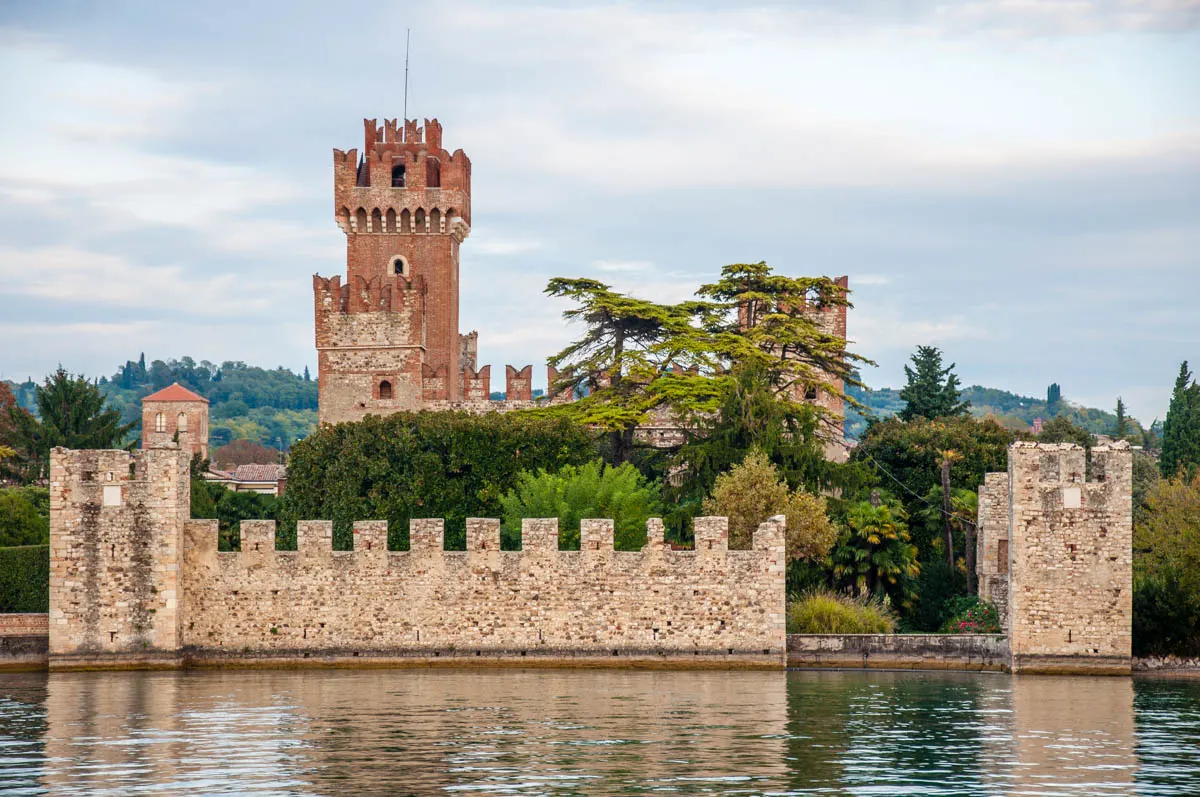
Lazise is the perfect holiday town on the shores of Italy’s Lake Garda. Going for a leisurely walk along its promenade, enjoying a gelato sitting on a bench next to its historic harbour or simply exploring the narrow streets of its historic centre, you feel like you have been transported into a beautiful cinematic experience that summarises what Italy stands for in our collective imagination.
The most striking thing about Lazise is its medieval Scaliger Castle and the massive defensive wall that surrounds the old town. Unlike other Scaliger Castles at Lake Garda on this list, the one in Lazise is private property and it’s not open for visits. Still, seeing its tall, robust towers and its crenellated walls is an experience in itself. Especially, if your first glimpse of this castle is from the water. If you take the ferry connecting Lazise to the other towns on Lake Garda or if you rent a boat to crisscross the lake as you please, you will have the opportunity to see the castle like travellers, merchants, and soldiers approaching Lazise did centuries ago.
The first fort was built here in the 9th century during the Hungarian invasions of the lands around Lake Garda. Later on, Lazise was annexed by Verona and starting in 1329, fortified walls and a moat were built around the whole town. For its strategic position on the lakefront, Lazise functioned for many centuries as a defensive outpost. Three large gates with drawbridges allowed access to the town. There was also a well-protected harbour, a fortified customs house, and a castle to match.
The castle was built by the Scaliger dynasty between 1375 and 1381. In the centuries that followed, Lazise changed hands several times. Each new ruler of the town – from the Visconti dynasty of Milan and the Republic of Venice to the French and the Austrians – left their imprint on the castle. By the 19th century, Lazise’s Scaliger Castle was in a state of neglect and the locals would extract stones and other useful building materials from its medieval structures. The castle was saved by Count Burri who bought it in the 19th century and began an extensive restoration process.
A spacious public park nestles between Lazise’s old defensive walls and the castle. There is a large playground there and lots of green grass and trees to spend a few relaxing moments on a hot day. It’s a great place to admire the castle from. Its walls – dotted with towers – and its keep stand proud and still – guardians of centuries-old stories. You cannot help but think ‘If only walls could talk!’.
4. Lombard Fort on Rocca di Garda on Lake Garda, Italy
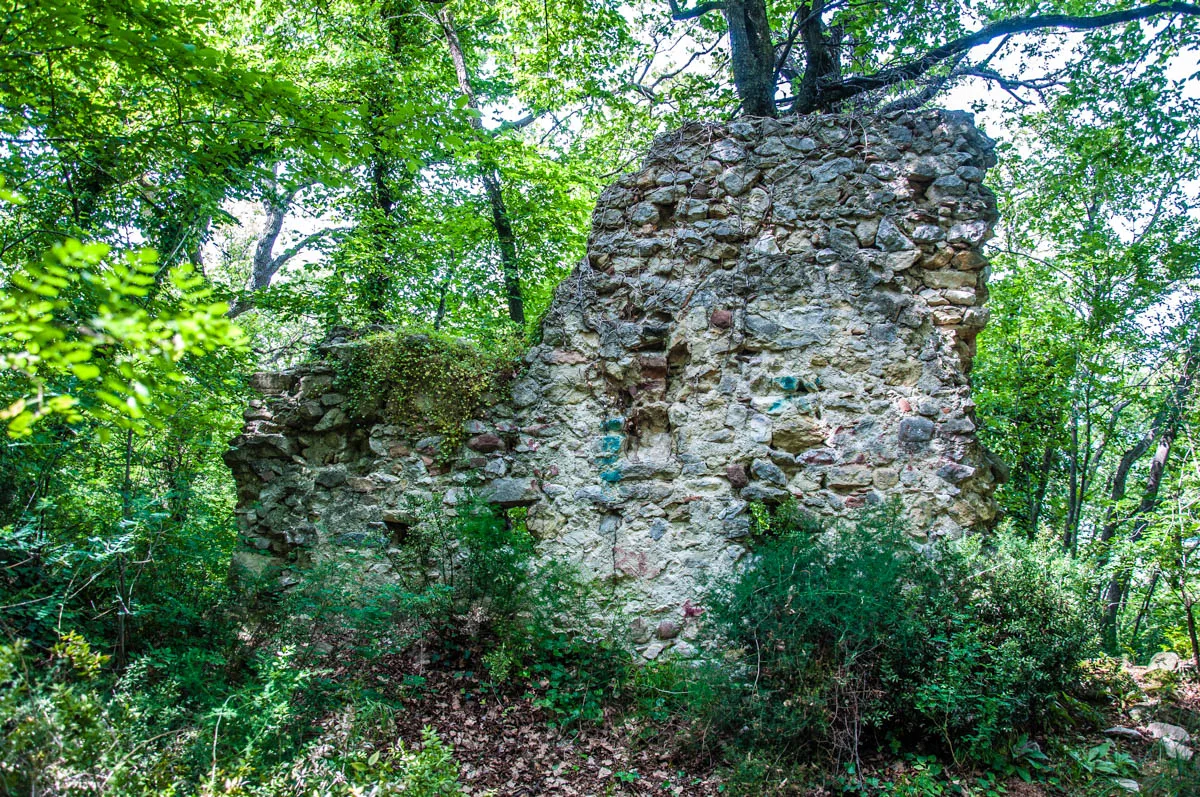
Rocca di Garda is a large flat-top hill that overlooks two of the most beautiful towns on the shores of Lake Garda. With the town of Bardolino on the left and Garda Town on the right, Rocca di Garda commands stunning views of Italy’s largest lake.
In the 5th century AD, a fortress was built here by the Germanic Lombards. It soon became a lively administrative centre. Its importance was such that it led to the lake changing its name – from the Latin Benacus it became Garda by the start of the 8th century. Garda comes from the ancient Germanic term Warda or Warte meaning place of observation, guarding place, or fortress. Curiously enough, the Italian word for fortress, rocca, gave the hill its current name – Rocca di Garda.
With its hilltop position, this early medieval fortress was practically unassailable. It was surrounded on three sides by steep natural cliffs and a large defensive wall was protecting the easter slope of Rocca di Garda. At the end of the 12th century, the fortress was ceded to the town of Verona in exchange for 700 silver coins. In the 13th century, the fortress was destroyed by its own defenders for unknown reasons.
Very little survives to this day of the original fortress. Hiking up the hill, near its top you come across vestiges of once sturdy walls and an old stone road. The ruins are covered with lush vegetation and spotting them adds to the beauty of the place.
The hike to the top of Rocca di Garda is relatively easy and short. It’s uphill but it’s not difficult to navigate. The views from the top are absolutely stunning. You can admire a bird’s-eye view of both Bardolino and Garda Town, the marinas of both towns, the romantic Punta di San Vigilio, the nearby hills and mountains, and in the distance you can glimpse the charming town of Sirmione.
It is worth it to do the hike to both see the views and the remnants of the fortress. Especially, knowing that it was this fortress that gave Lake Garda its name.
More Info:
5. Scaliger Castle in Torri del Benaco on Lake Garda, Italy
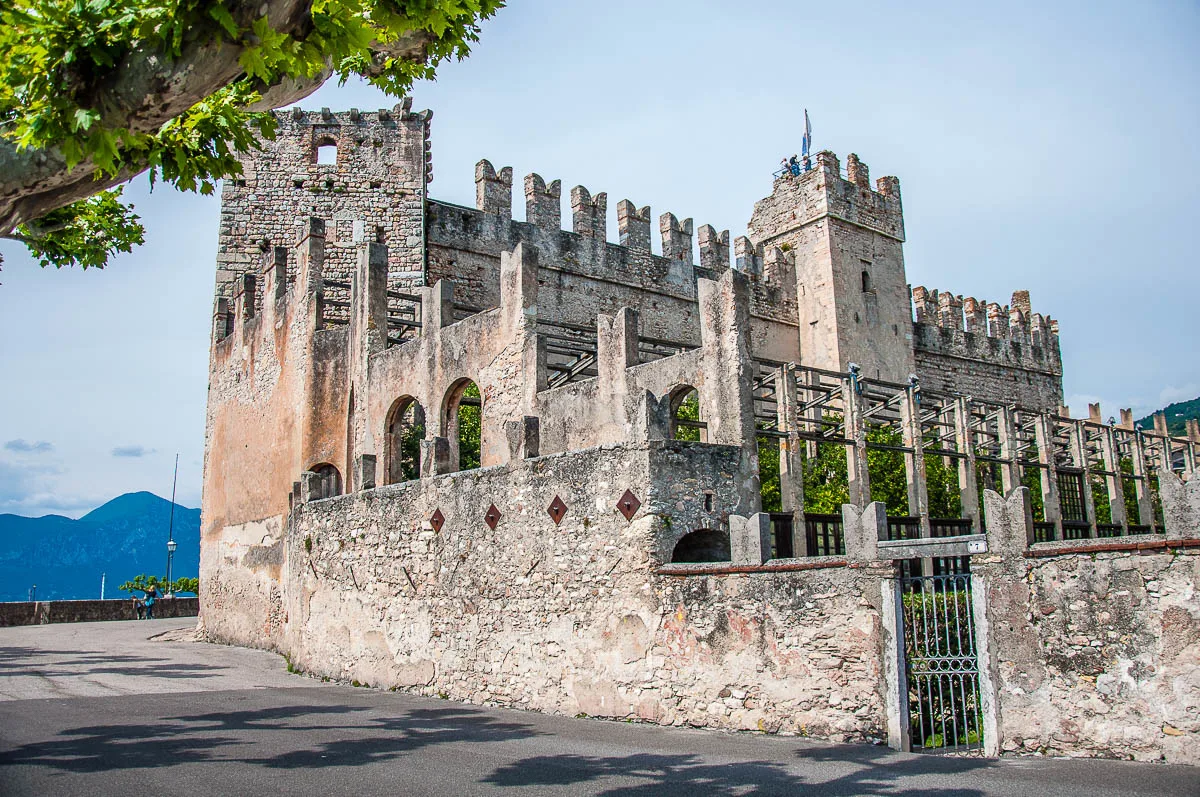
A sturdy medieval castle stands sentry over Torri del Benaco’s historic centre. You will see it from afar as you are approaching this small town on Lake Garda.
A fort has stood at this spot since Roman times when Torri del Benaco was known as Castrum Turrium. Later on, in the 10th century, Berengar I – King of Italy from 887 AD and Holy Roman Emperor from 915 AD until his death in 924 AD – erected a castle on top of the Roman ruins. In addition, he surrounded the whole town with a thick defensive wall dotted with watchtowers. Passages were also excavated underground to be used in case of sieges by the invading Hungarians.
The castle as we see it today was built in 1383 on the orders of Antonio della Scala – Lord of Verona and member of the Scaliger dynasty. It incorporates a few surviving portions from Berengar’s castle among which is the Western tower. The Scaliger castle was built to protect the town’s port which at the time also functioned as a shipyard.
In 1405, when the Republic of Venice annexed Torri del Benaco to its territories, the castle became the residence of the Captain of the Lake. This was the local ruler who was in charge of the federation of ten lakefront municipalities and looked after the local interests of the Republic of Venice.
Nowadays, Torri del Benaco’s Scaliger Castle functions as a Historical Ethnographic Museum. A visit to it is a must for four reasons:
- The rooms of the castle host a very interesting exhibition tracing the history and traditions of the territory. From fishing and caulking to olive tree growing and olive oil pressing, the local crafts and occupations are thoughtfully explored. A visit gives you a first-hand understanding of how people used to live at Lake Garda over the centuries.
- Room number 9 of the museum contains an intriguing display about the history and the meaning of the many rock carvings found around the shores of Lake Garda. Some of them date back to pre-historic times and represent small figures of people and objects that have been chiselled on slickensides – rocks smoothly polished by ancient glaciers.
- At the back of the castle, you can visit a traditional for Lake Garda limonaia – a greenhouse for the cultivation of citrus fruit. Citrus trees were introduced around Lake Garda in the 14th century by the Franciscan monks. At one point in history, the lake was the northernmost place in the world where citrus fruits were grown commercially. The citrus greenhouse at the Scaliger Castle of Torri del Benaco was set up in 1760. Some of the lemon trees in it reach a height of ten metres and there is a small pond with fish and turtles at the entrance to the greenhouse.
- From the castle’s battlements, you can enjoy some of the loveliest views of Lake Garda and Torri del Benaco’s historic centre. Standing on the centuries-old towers feels like being on top of the world, especially on a clear sunny day when the eyes travel as far as Sirmione on the southern edge of the lake.
More Information:
6. Scaliger Castle in Malcesine on Lake Garda, Italy
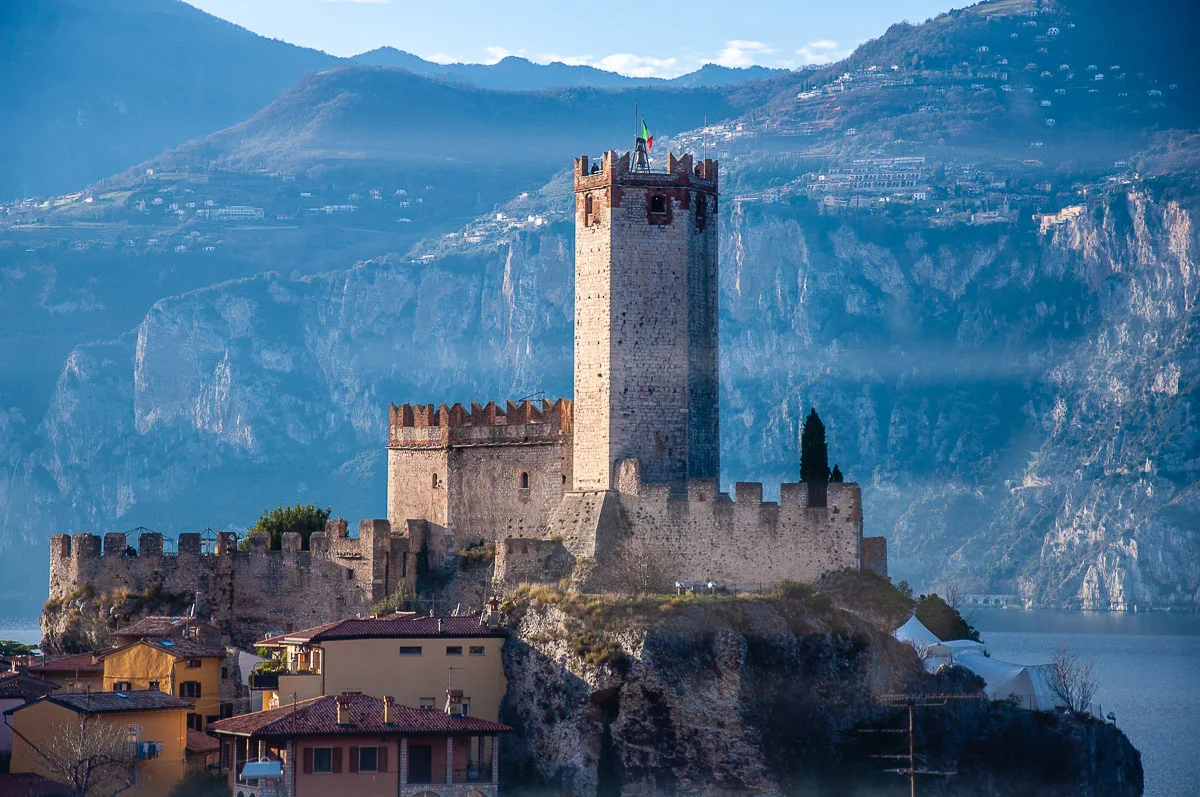
For me personally, the Scaliger Castle in the town of Malcesine is the most beautiful castle on Lake Garda in Italy. It’s built on top of a rocky outcrop and it crowns the small promontory to which the houses of Malcesine’s historic centre cling to. Its crenellated defensive walls seem to grow organically from the steep slopes. Seeing them together with the castle as you approach Malcesine sitting on the deck of a ferry or a boat is a breathtaking experience.
The history of Malcesine’s Scaliger Castle dates back to the early Middle Ages. The Lombards first built a fort here to control the navigation in the lake. The fort was destroyed and then rebuilt by the Franks at the end of the 6th century. In 1277, the fort became the property of Alberto della Scala who remodelled it into the Scaliger Castle we see nowadays.
Surrounded by cypresses, pomegranate and citrus trees, Malcesine’s Scaliger Castle is truly stunning. For many centuries, the town could only be accessed by water and the castle played an important role in protecting the territory and controlling the lake traffic. The Siresina Gate is the only point of entry to the castle and its grounds. A proud donjon stands above the different buildings and courtyards surrounded by sturdy walls.
Nowadays, the so-called Casermetta – one of the Scalier Castle’s main buildings – hosts the local Natural History Museum of Monte Baldo and Lake Garda. In the Goethe Room of the castle, you can admire sketches of Lake Garda and Malcesine drawn by the famous German poet, playwright, and novelist Johann Wolfgang von Goethe.
Goethe visited Malcesine in September 1786 and busied himself sketching its Scaliger Castle. The locals thought that he was an Austrian spy and petitioned the mayor to arrest him. It was only through the advocacy of a local man who had spent years in the writer’s home city of Frankfurt, that it was established that Goethe was in fact German and he could continue free on his Italian journey.
Another curious thing to see in Malcesine’s Scaliger Castle are the remnants of Venetian ships from the first half of the 15th century. Due to a military conflict between the Republic of Venice and the Duchy of Milan, the boats had been transported from the Adriatic Sea to Lake Garda first up the River Adige and then by land. The overland transport of boats at the time was a daring engineering enterprise. It became known as Galeas per montes (in English, Galleys over Mounts).
Malcesine’s Scaliger Castle is a great place to visit for its history and the stunning views its hilltop position affords. One of the best things about it though is the secret beach right at its foot. If you follow the curves of the defensive walls and navigate two flights of steep stone steps, you will find the beach yourself. It’s absolutely tiny but so beautiful!
7. Arco Castle in Arco near Lake Garda, Italy
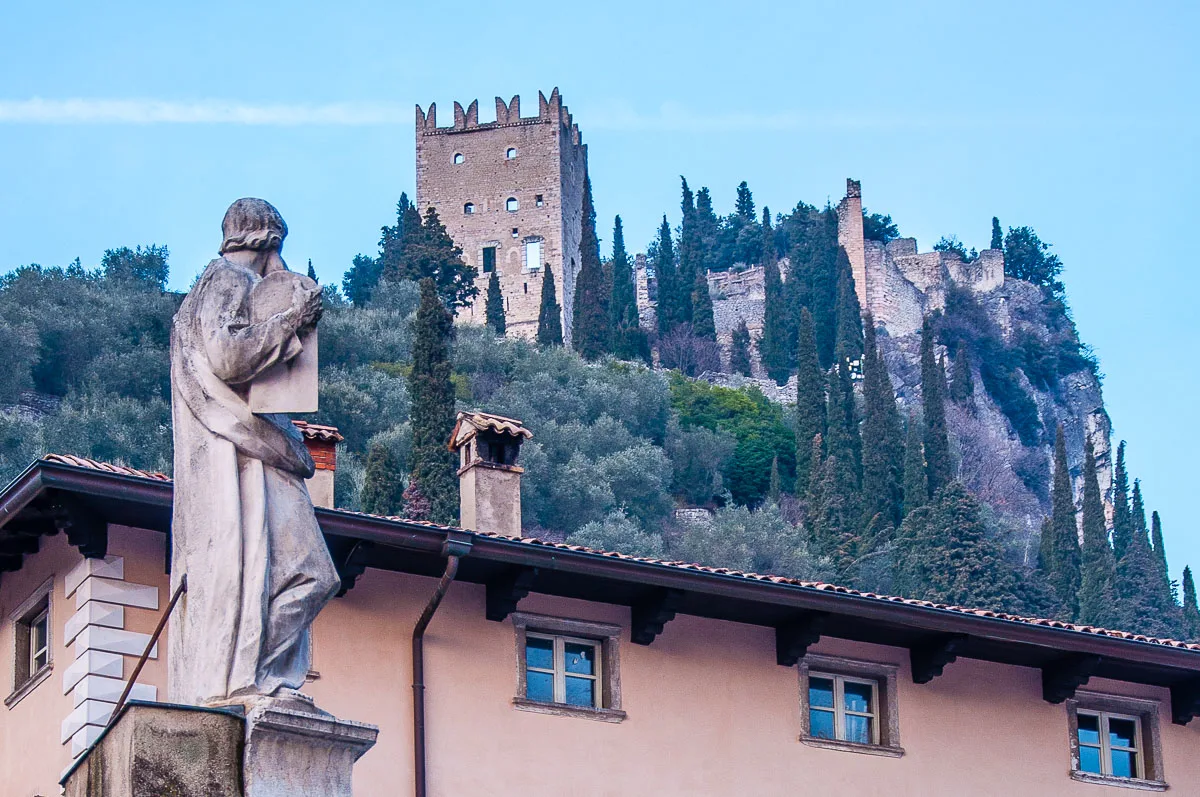
Arco is an elegant town just off the northern extremity of Italy’s largest lake – Lago di Garda. Surrounded by sheer limestone cliffs, Arco has a ruined castle and several beautiful churches and palaces. The town has a very Tyrolean feel to it and it is interesting to note that the Habsburg Court used to spend the summers here when this part of Italy was under the rule of the Austro-Hungarian Empire. Empress Sisi herself would come to Arco, too.
Arco Castle stands tall and proud on top of a steep spur. Nowadays in ruins, during the Middle Ages, the castle controlled the vast valley of the River Sarca which flows into Lake Garda. The views from up there are soul-inspiring.
The path leading to Arco Castle starts from the town’s historic centre. It takes you through olive groves and up the hill to the majestic ruins. On average, you need about 20 mins to navigate it although you will be tempted to stop every minute or so just to take it all in and as many photos as possible.
Curiously enough, Arco Castle was immortalised by the painter, printmaker, and engraver Albrecht Durer who is recognised as the greatest German Renaissance artist. He painted his View of Arco in 1495 and nowadays the watercolour is part of the collection of the Louvre in Paris, France. Durer’s painting shows the castle at its peak as an unassailable fortress the defensive walls of which also protected the town of Arco at the bottom of the hill.
The beginning of the 18th century brought the rapid decline of Arco Castle. The locals, as it was often the case under similar circumstances, began using its fortifications as an easy source of building materials. After an expansive conservation and restoration process in the 1980s, Arco Castle nowadays welcomes visitors who come to admire the splendid views, the fragments of frescoes depicting ladies and knights playing chess and throwing dice, as well as the multilayered history of this beautiful corner near Italy’s Lake Garda.
8. Rocca di Riva in Riva del Garda on Lake Garda, Italy
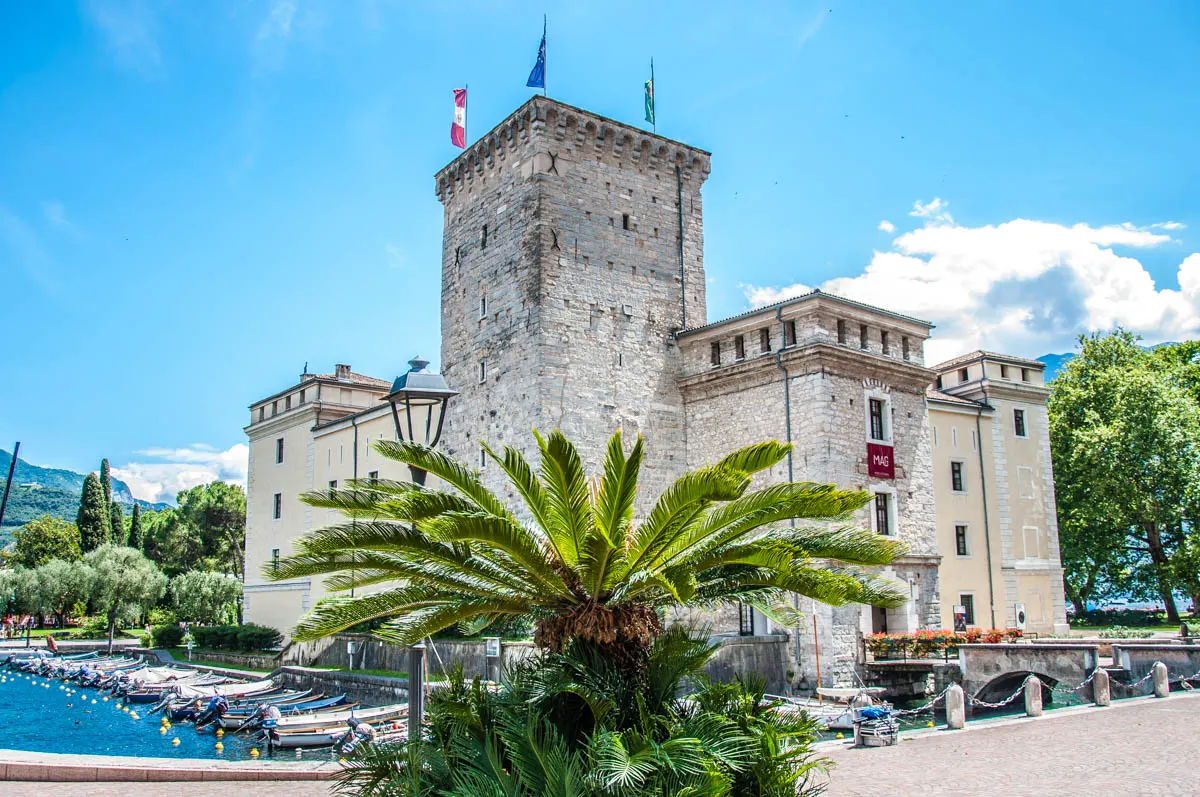
Riva del Garda is one of the most popular towns on the shores of Lake Garda in Italy. With its pastel-coloured houses, Austrian heritage, sparkling beaches, and a long list of activities for sports aficionados, Riva del Garda attracts thousands of visitors each year.
Rocca di Riva is one of the town’s most important sights. This is a medieval fortress that stands on a small artificial island in the historic centre of Riva del Garda. The fortress is surrounded by water on all sides and a small bridge leads to its entrance. Rocca di Riva was built in 1124 in order to protect the town’s important port.
When the town was taken over by the Scaliger dynasty of Verona in the 14th century, the fortress was restructured in line with the architecture of the Scaliger Castles in Lazise, Peschiera, and Sirmione. In other words, Rocca di Riva was enlarged and surrounded by a deep moat. During the Venetian dominion of this corner of Lake Garda, the fortress bore witness to the battles between the Republic of Venice and the Duchy of Milan.
By the 16th century, Rocca di Riva had changed completely its purpose and had become a residence first hosting the Prince-Bishops of Trento and then private individuals. Three centuries later, the fortress was turned into army barracks.
Nowadays, Rocca di Riva is one of the two structures housing the exhibits of the Museum of Upper Garda. It has interesting archaeological, historical, and art sections introducing you to the history and the traditions of Trentino – the autonomous Northern Italian province of which Riva del Garda is part.
Going for a walk through the historic centre of Riva del Garda, you cannot miss this important historic building. With palm trees and fountains next to it and enjoying a great lakefront position, Rocca di Riva is a must-see on the northern tip of Italy’s Lake Garda.
9. Castle in Desenzano del Garda on Lake Garda, Italy
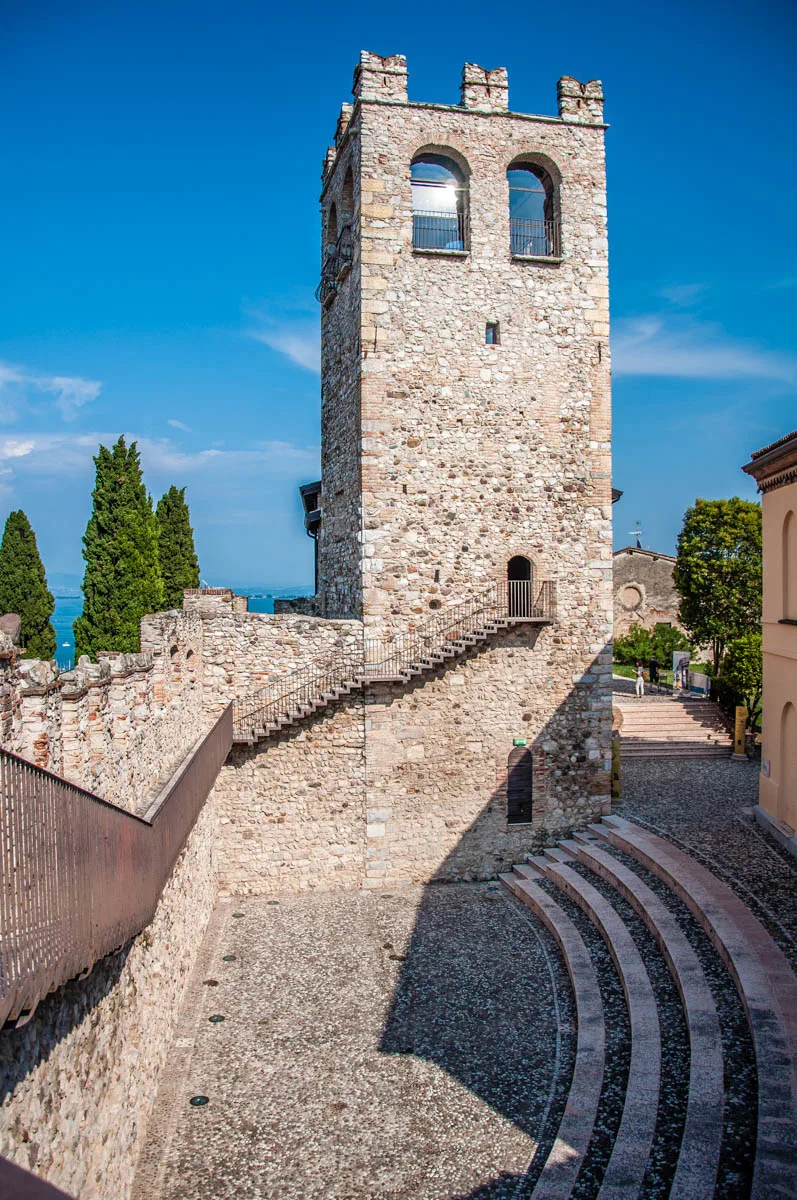
Desenzano del Garda is the largest town on the shores of Lake Garda in Italy. It has a number of unmissable sights. Among them are the ruins of a Roman villa and a nicely preserved hilltop castle.
A visit to Desenzano’s medieval castle will take you through the town’s curviest and steepest streets where colourful tall houses preside over tables placed outside in front of the local trattorias and restaurants. The uphill walk only lasts a few minutes but every effort you invest in it will be richly rewarded with the stunning views over red rooftops and blue lake waters that suddenly will open in front of you as soon as you reach the castle.
You can stop at the small landing in front of the castle’s main entrance and enjoy the views from there. For the best panorama though, make sure that you pay the small entrance fee to explore inside. From the top floor of the castle’s donjon, you can enjoy a 360-degree view of Desenzano, Lake Garda, and the adjacent territory.
The castle of Desenzano del Garda was erected more than ten centuries ago at the same spot where the Romans once had a fort and a town. Originally, the medieval castle served to protect the local population from raids and marauding. At one point there were about 120 houses and artisan workshops built inside the castle’s walls. By the 19th century though, the castle was housing military barracks.
Nowadays and after an extensive restoration, this medieval castle proudly presides over Desenzano del Garda. Its courtyard has been transformed into an open-air stage where concerts and other cultural events often take place.
10. Scaliger Castle in Valeggio sul Mincio near Lake Garda, Italy
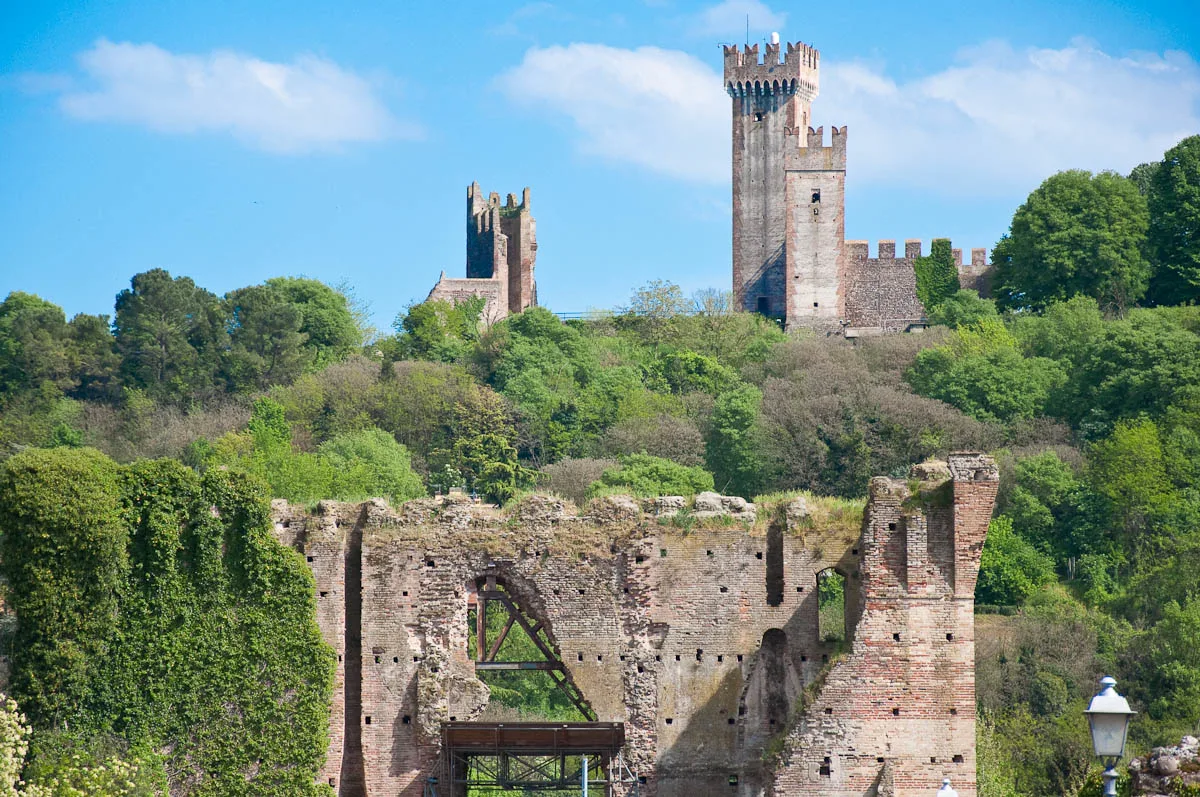
Valeggio sul Mincio is a small town on the River Mincio. It’s less than 15 minutes away from Peschiera del Garda and around 35 mins away from Verona. It is famous for the local delicacy – handmade tortellini prepared with different fillings. Valeggio is where you can visit one of Italy’s most beautiful gardens – Parco Giardino Sigurta’. It’s also right next door to the small hamlet of Borghetto sul Mincio with its ancient mills built right above the fast rushing waters of the River Mincio.
Most importantly, in Valeggio sul Mincio you can see another mighty Scaliger Castle. It crowns the hilltop above the town, it dominates the valley of the river, and its crenellated towers provide the dramatic backdrop for Parco Giardino Sigurta’. A 14th-century bridge spans the river and in the past was connected directly to the castle via two tall crenellated curtain walls. The bridge was built by the Duque of Milan – Gian Galeazzo Visconti. It’s 650 long, 21 m wide and it’s eight metres above the River Mincio.
The castle itself was first built in the 10th century but then in 1117 a strong earthquake almost destroyed it. Between the 13th and 14th centuries, the Scaliger dynasty from Verona re-structured and re-built the castle. In the centuries that followed the Scaliger Castle of Valeggio sul Mincio suffered a slow decay. Nowadays, the castle is a lovely place to visit in order to admire the picture-perfect views and to feel closer to history.
Scaling the steep path from Borghetto sul Mincio to the hilltop Scaliger Castle is a great exercise after indulging in a plate or two of tortellini in the local restaurants. Bear in mind that this medieval castle is allegedly haunted by the spirit of its former lord – Andriolo da Parma. At the beginning of the 15th century, Andriolo conspired to surrender his castle to the Republic of Venice. This enraged the Lords of Padua who at the time controlled the lands around Valeggio and Borghetto.
Andriolo was captured and then promptly quartered. They say that since then, on full-moon nights his ghost haunts the Scaliger Castle and the locals tend to stay away from it then.
The Lake Garda Castle That Got Away
I spent six years living in Italy in a small city called Vicenza about an hour away from the southern end of Lake Garda. We often spent days and long weekends on the shores of this beautiful and largest Italian lake. We were always eager to see more of it, of its towns and villages, of its sights, its nature, and its castles.
I had a long list of sights I was eager to see there and I was fortunate to be able to cross off so many of them. The one castle near Lake Garda that I really wanted to see and yet we never found the time to visit was the Rocca di Lonato in the small town of Lonato del Garda. We drove past it so many times, always hurrying towards another destination. I so really interested in the frescoes and the library of this castle, and yet, every time that we organised another Lake Garda trip, I somehow always forgot to add Lonato to the plan.
Nevermind! I hope one day soon to return to Lake Garda in Italy and to see Rocca di Lonato then. If, in the meantime, you have a chance to visit it yourself, let me know what you think! Thank you!
Map of 10 Beautiful Castles to Visit Around Lake Garda, Italy
Practical Tips about Visiting Lake Garda in Italy
Where is Lake Garda?
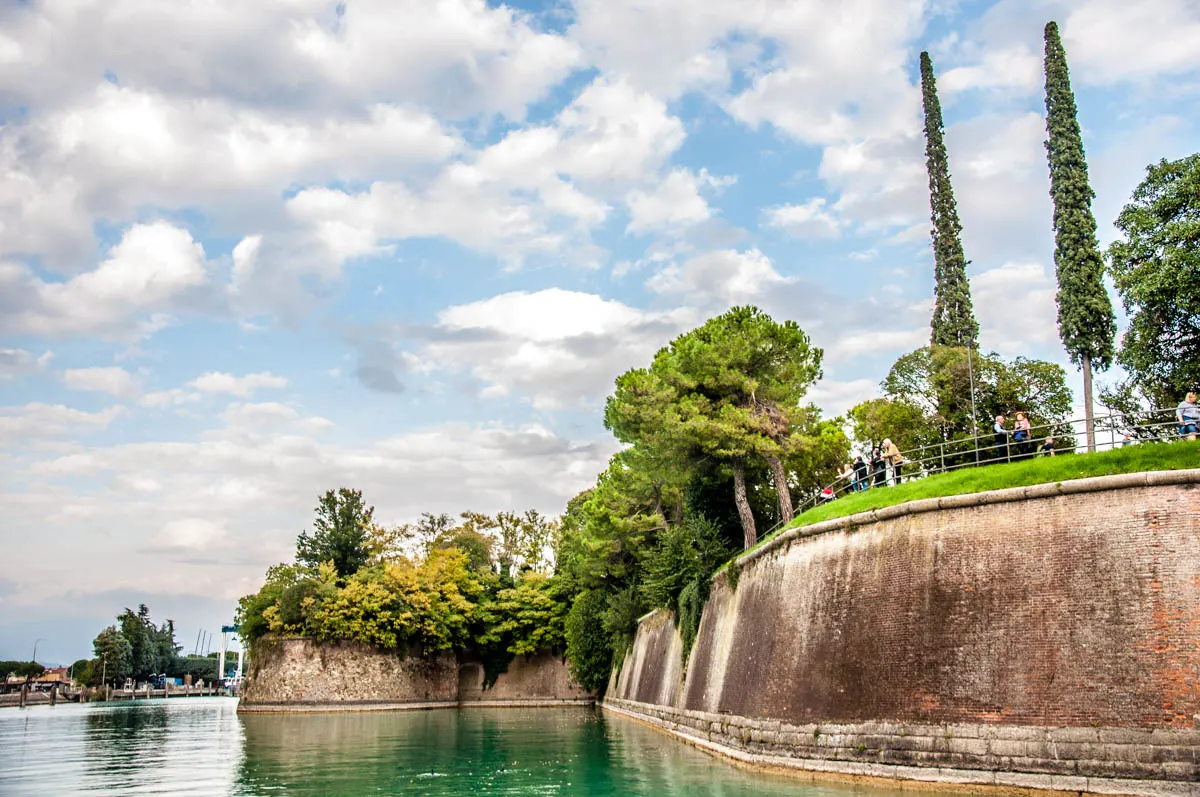
Lake Garda is in the northeastern part of Italy. It is within close proximity to some of the most important and well-known Northern Italian cities like Verona, Brescia, Milan, Padua, and Venice. The lake serves as a natural border between three Italian regions – Veneto, Lombardy, and Trentino-Alto Adige – thus giving you a chance to experience their traditions, food, and history within a short amount of time and distance.
Called by the Romans Lacus Benacus the lake took its current name around the 8th century AD. It was inspired by the name of a Germanic Lombard fortress on its shores. Garda is a corruption of the original Germanic word warda meaning ‘place of guard’ or ‘place of observation’.
What is the geography of Lake Garda?
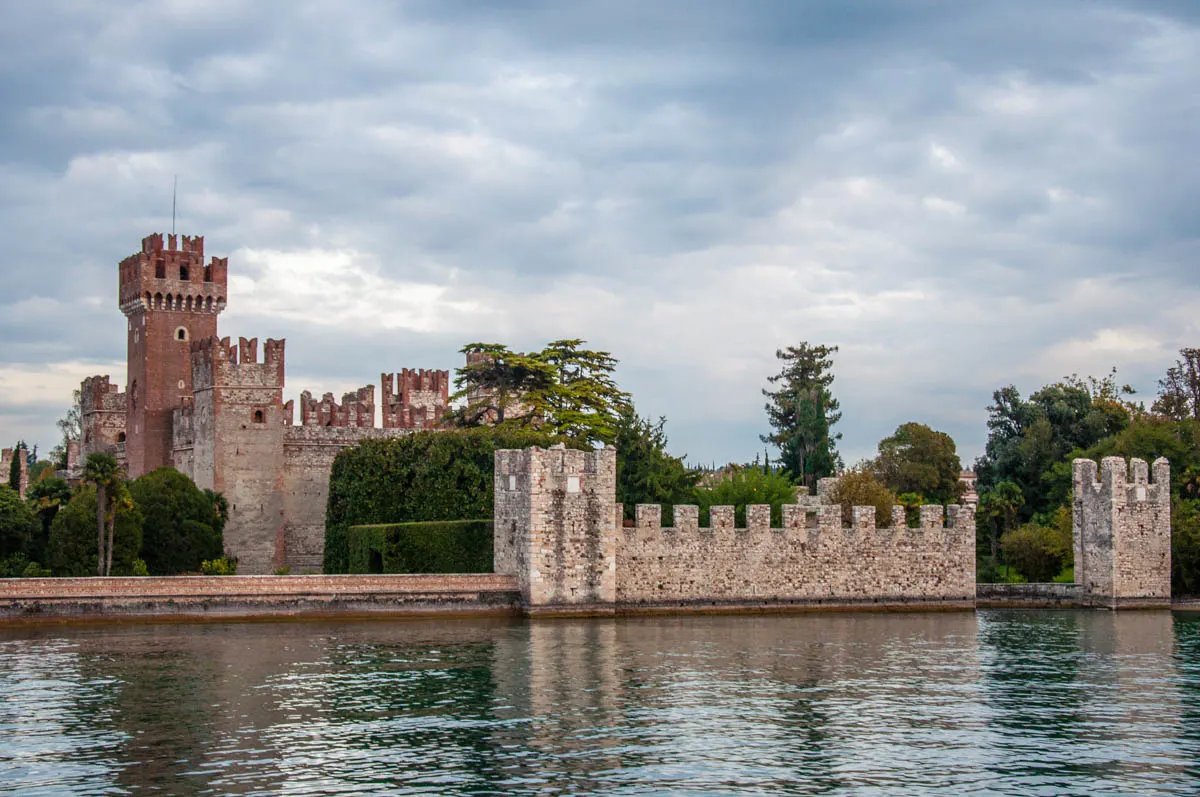
Imagine a long narrow basin of water being held in a tight embrace by tall, powerful mountains to the north. To the south, the landscape flattens and the lake spreads out with wild Italian abandon. Vineyards and olive, citrus and palm trees dot the steep rugged slopes and the verdant plains. The blue waters of the lake glint under the hot Italian sun. Huddled on the shores are picturesque towns, each one with its own character and appeal.
Lake Garda is a glacial lake surrounded by Alpine mountains. One of the most important of them is Monte Baldo which is also known as the Garden of Europe as it is incredibly rich in botanical species, among which are 62 types of orchids.
Which are the nearest airports to Lake Garda?
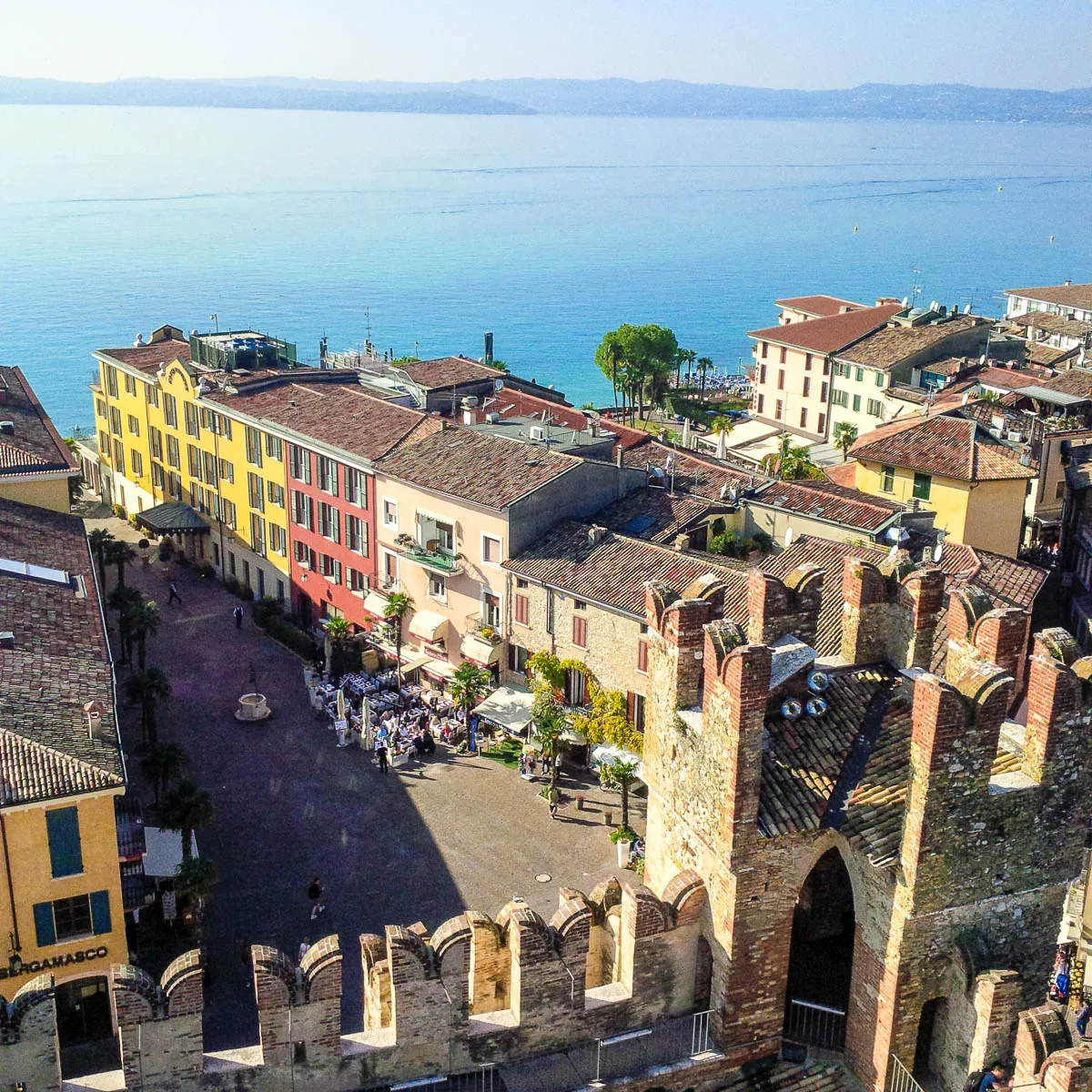
Click to read 8 Best Airports for Lake Garda or How to Reach Quickly by Plane Italy’s Largest Lake for detailed information on the most convenient airports for Lake Garda and how to reach the lake from each one of them by public transport.
How to travel around Lake Garda?
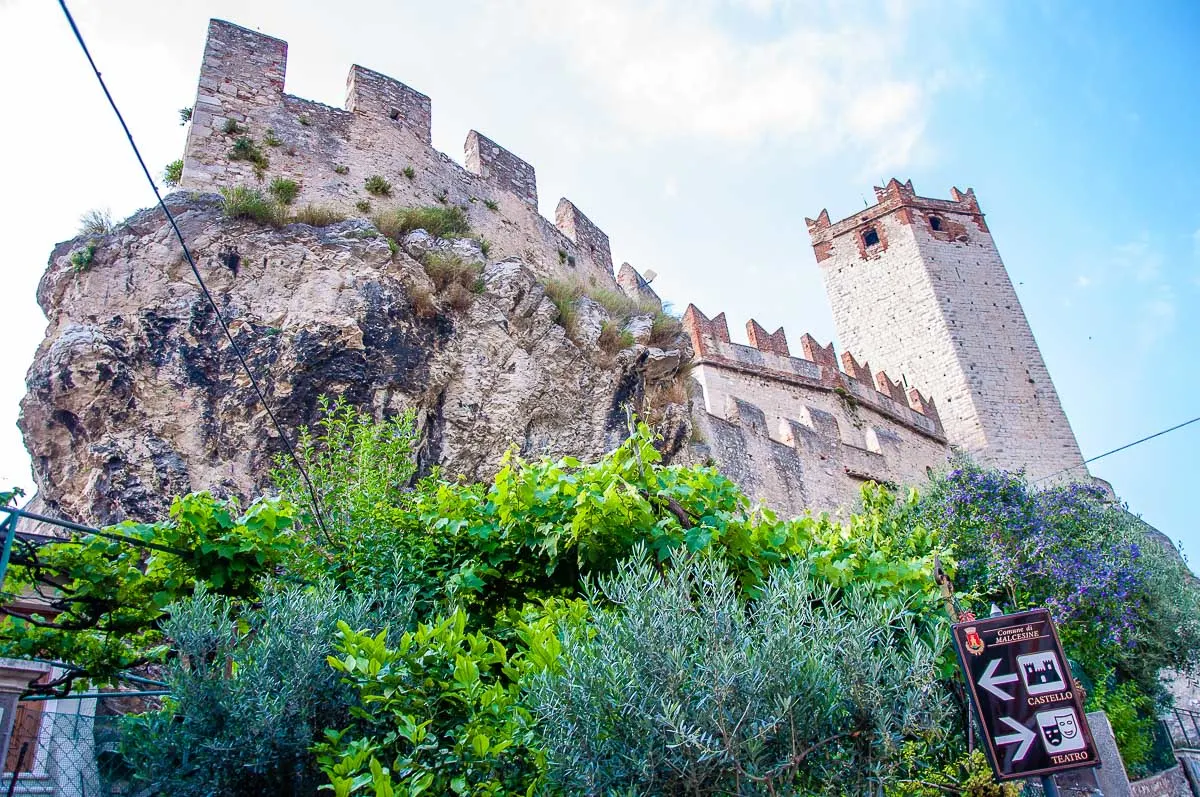
Click to read Getting Around Lake Garda – 8 Best Ways to Travel Around Italy’s Largest Lake for detailed information on the best ways to travel around and across Lake Garda by car and public transport.
Do I need a car to explore Lake Garda?
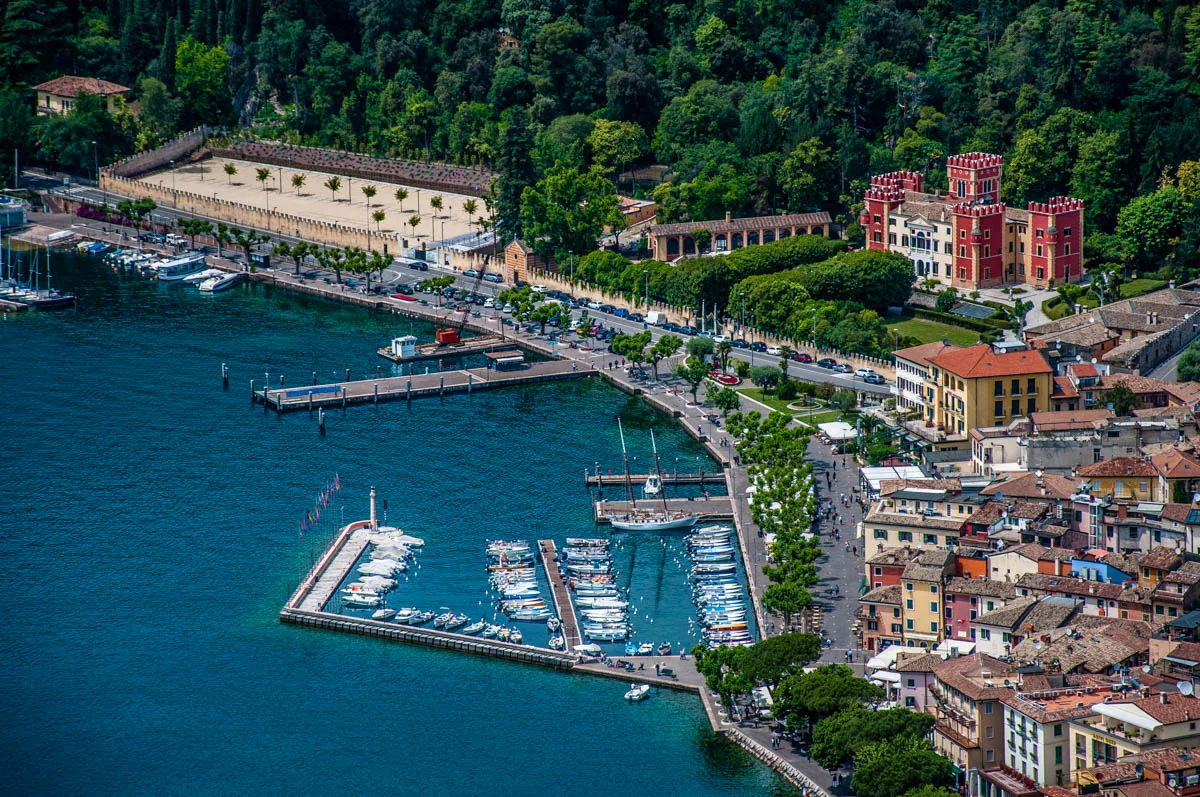
Click to read Getting Around Lake Garda – 8 Best Ways to Travel Around Italy’s Largest Lake in order to get a good idea of how transport around the lake is structured. Depending on the number of days you are planning to spend at Lake Garda, where you are arriving from, and where you will be based around the lake, you may need or may not need access to a car. The linked blog post will give you pointers to make the best decision for yourself.
When is the best time to visit Lake Garda?
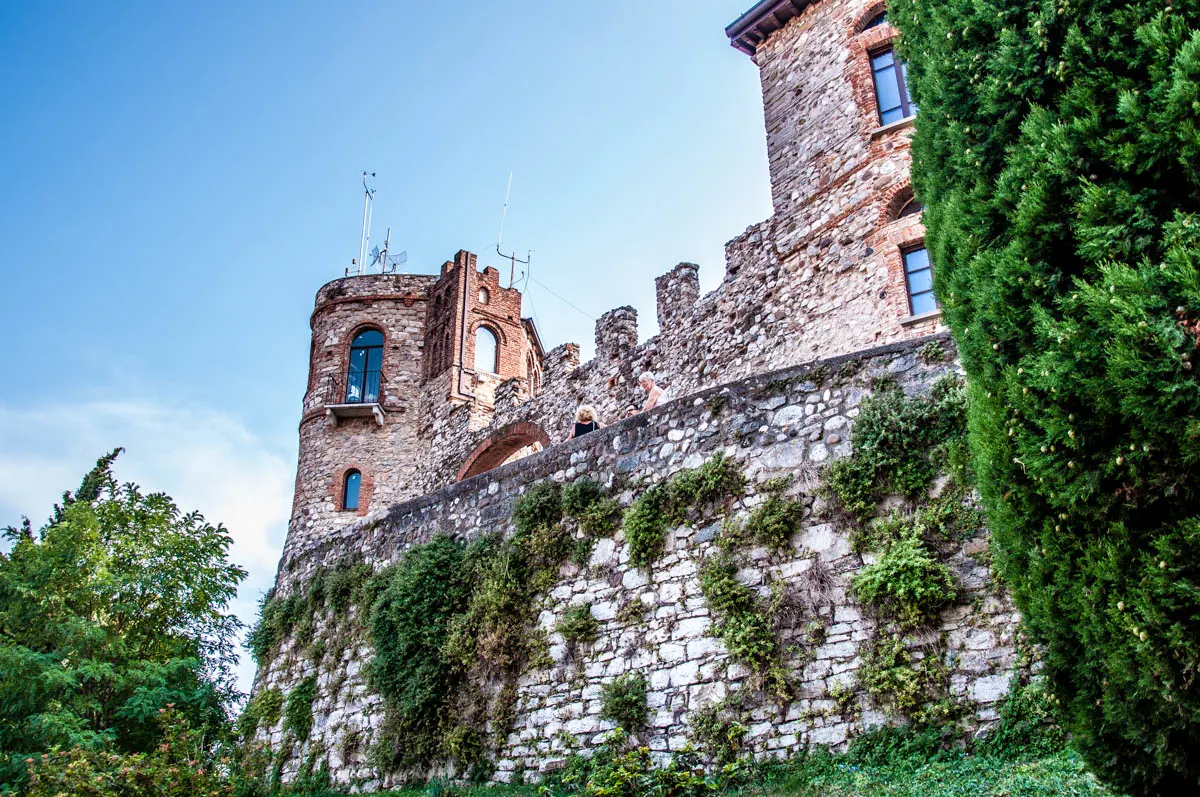
It really depends on what you are looking for. If it is beautiful views, great hiking, amazing food, and historic towns, feel free to come at any time of the year. The lake is gorgeous in any season.
Late autumn, winter, and early spring are mostly crowd-free and offer many different types of local entertainment like Christmas and craft markets, food and wine festivals and so on. When the weather gets warm though people start flocking to Lake Garda. In July and August, the streets are densely packed while the sun really shines above you making you seek and crave shade.
My favourite time to visit Lake Garda with my family is during the low season. Any time from the end of October to the end of April, when we can explore the area in peace.
If you don’t have any other option but to come here during the hot summer months or if you really love hot weather, then, don’t let me stop you. Lake Garda offers many different surprises in every season so summer is a great time to be here, too.
What types of accommodation there are around Lake Garda?
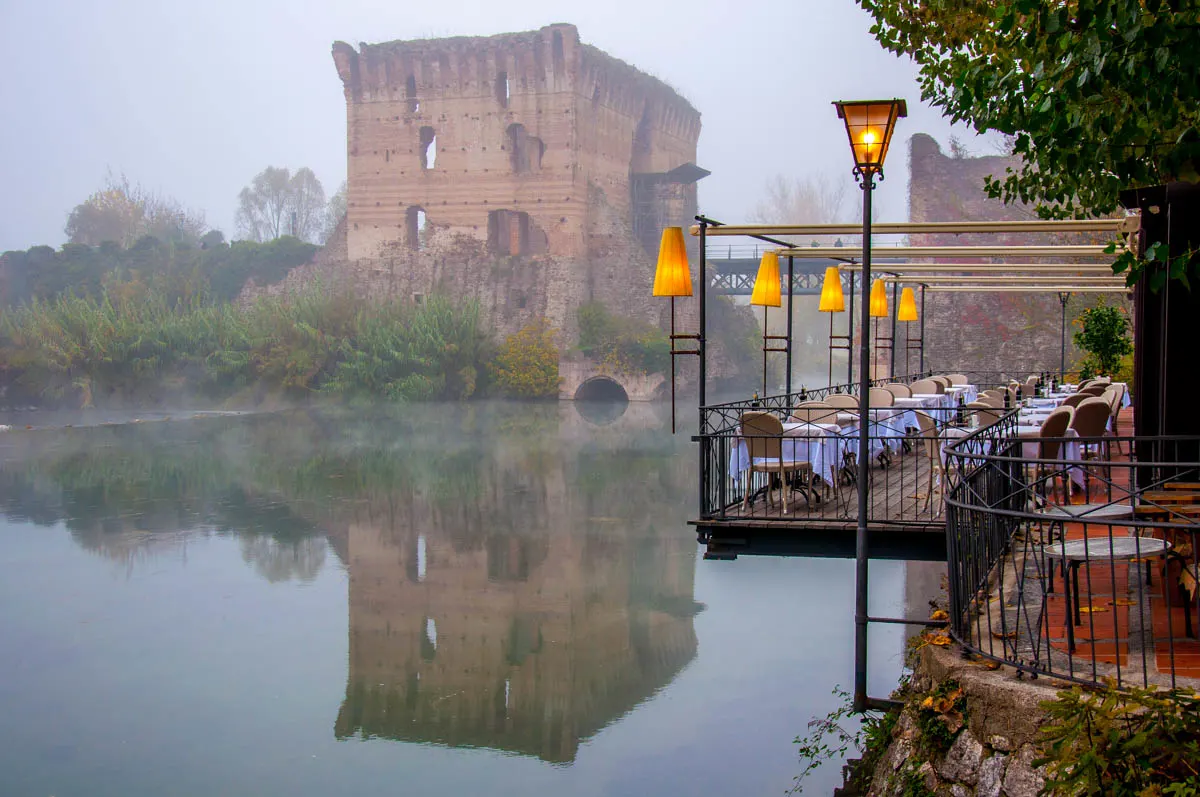
You can find all sorts and types of accommodation around Lake Garda to suit any budget. From five-star hotels to budget camping sites, there is something for everyone. Apart from the traditional hotels and B&B’s, here you can also stay on a working farm (called agriturismo), a glamping site or a luxury villa for a one-in-a-lifetime experience.
For ideas about the types of accommodation available at Lake Garda in particular and Italy in general, have a look at this blog post:
Make sure that you book well in advance, as the lake is a very popular tourist destination and prices can rise steeply depending on the season and how little time there is between now and your visit.
Have a look at this map. It gives you a quick visual idea of the many hotels and other forms of accommodation you can book for your stay at Lake Garda, Italy. You can zoom in and out in order to search for accommodation in the precise lakefront town you want to stay in:
Which are the best towns to visit around Lake Garda?
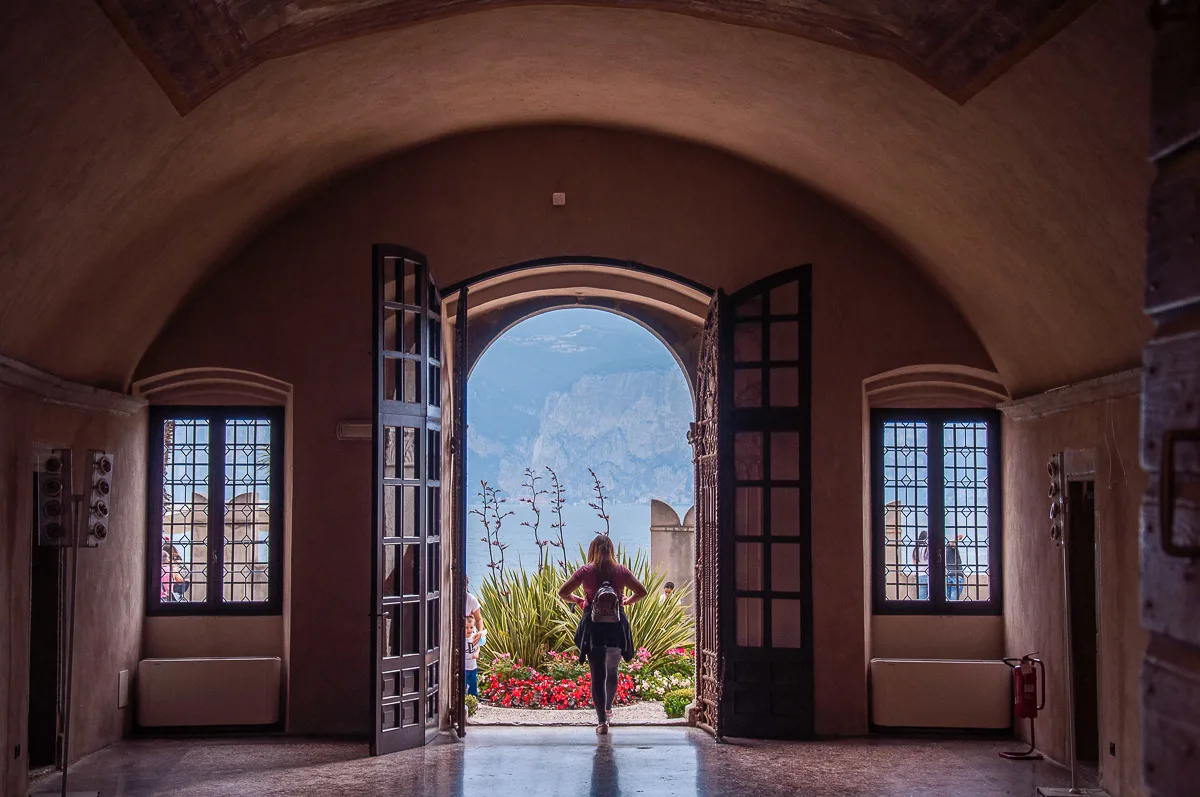
There are dozens of charming towns and villages on the shores of Lake Garda waiting to be discovered by curious and adventurous travellers.
For a detailed list of the 12 best towns to visit around Lake Garda, please, click here. It gives you a detailed overview of the medieval walled towns, the party centrals, the cultural hubs, and the hiking grounds you can explore on the lake’s shores.
If I were pressed to choose, then I will tell you that my all-time favourite Lake Garda towns are Malcesine and Sirmione. Yet, don’t miss any chance you have to explore as many lakefront towns and villages as you can while you are here.
In Conclusion
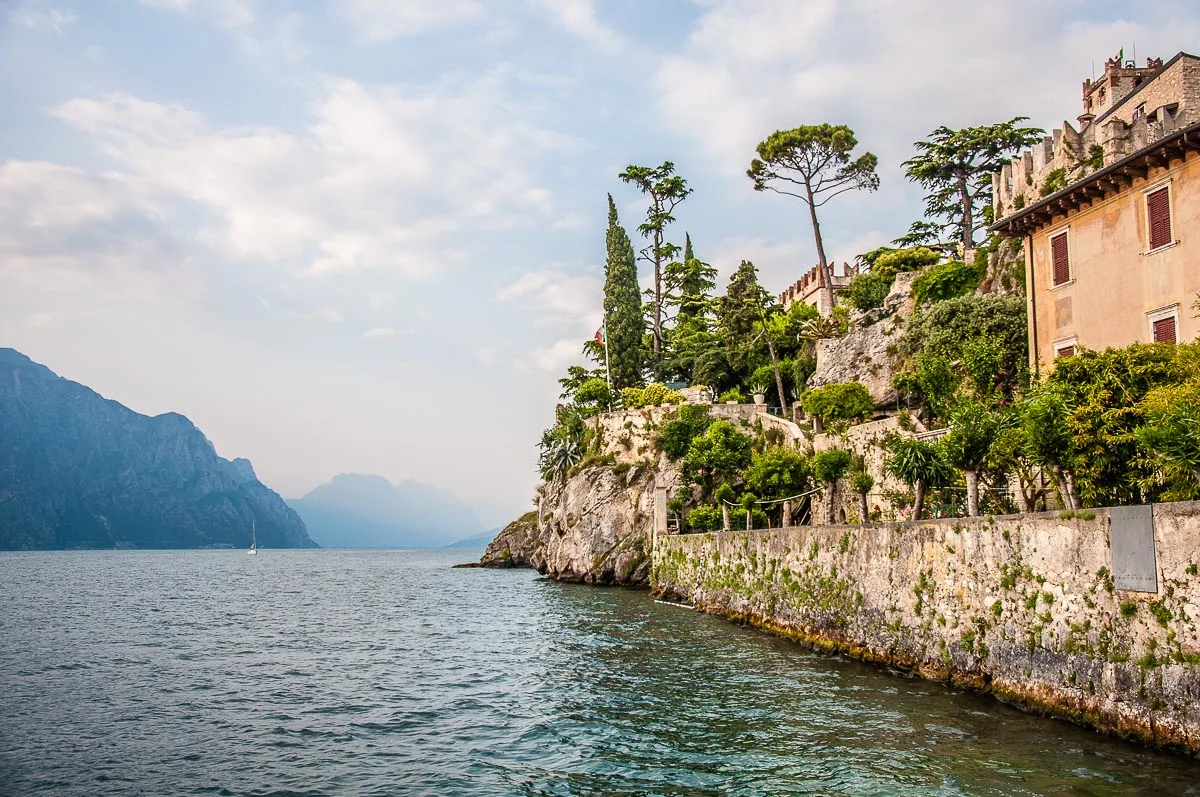
Lago di Garda is a wonderful destination in Northern Italy. This is Italy’s largest lake and it offers a long list of sights and activities to keep you busy during your visit to the area.
One of the best things to do around Lake Garda is visiting the many medieval castles and forts here. Erected in picturesque locations and with a multilayered history that spans many centuries, they are beautiful and intriguing to see. Many of them nowadays host well-curated local museums, too.
In the above blog post, I share with you ten beautiful castles to see for yourself around Italy’s Lake Garda. I have provided lots of details about the history of each one of them and have also included my personal impressions of visiting them.
I hope that you found this blog post helpful and that it gave you the impetus that you needed to head to this beautiful corner of Italy!
Enjoy visiting the castles of Lake Garda!
Now, get ready quick for your visit to the castles of Lago di Garda in Italy!
- Consult these guidebooks.
- Buy plane tickets to Italy.
- Book train tickets, bus tickets or rent a car.
- Research accommodation.
- Select tours and activities.
More Helpful Lake Garda Info for You
Lake Garda Towns and Villages: Best Towns, Riva del Garda, Malcesine, Torri del Benaco, Punta di San Vigilio, Campo di Brenzone, Borghetto sul Mincio
Lake Garda Hiking: Tibetan Bridge, Rocca di Garda, Park of the Waterfalls
Visiting Lake Garda: Map of Sights, Towns, and Activities, Lake Garda with Kids, 8 Best Airports, Milan to Lake Garda, Venice to Lake Garda, Verona to Lake Garda, Bologna to Lake Garda, Travel Around Lake Garda
Lake Garda Beaches: 16 Top Tips, 3 Unmissable Beaches
Lake Garda Sights: Theme Parks, Best Castles, Shortest River in Italy, Sanctuary of Madonna della Corona
More Helpful Italy Info for You
Lakes in Italy: Lake Como, Lake Caldonazzo, Lakes in Trentino, Lakes in Veneto
Best of Italy: Italy Gift Guide, Italian Piazzas
Northern Italy: 10 Reasons to Visit, 18 Best Cities to Visit, Major Airports
Veneto: Best Cities to Visit, Top 15 Places, 30 Adventures, 15 Most Colourful Places
Friuli Venezia Giulia: Venzone, Most Beautiful Villages
Emilia Romagna: Bologna, Ravenna, Comacchio, Most Beautiful Villages
Marche: 6 Reasons to Visit, Gradara, Frasassi Caves, Temple of Valadier
Trentino: Cities and Towns in Trentino, Rovereto, 15 Amazing Places
Venice: Essential Tips, Major Landmarks, Hidden Gems, How to Navigate Venice, Venice in a Day for Art Lovers, Train Stations, Nearest Airports, Best Tours, Boats in Venice, Haunted Venice, Day Trips from Venice, Arco del Paradiso
Verona: Things to Do in One Day, Verona Opera Festival, Day Trips from Verona
Padua: Things to Do in One Day, 101 Facts About Padua, 10 Reasons to Visit Padua, Day Trips from Padua
Vicenza: Things to Do, Best Museums, Day Trips from Vicenza
Day Trips in Italy: Bologna to Verona, Milan to Verona, Venice to Verona, Bologna to Venice, Milan to Venice, Florence to Venice, Verona to Venice, Venice to Padua
Thank you for reading! Please, leave me a comment, pin the images or use the buttons right at the top and at the end of this blog post to share it on social media.
For more useful information like this, please, like my blog’s page on Facebook and subscribe to my strictly no-spam newsletter.
